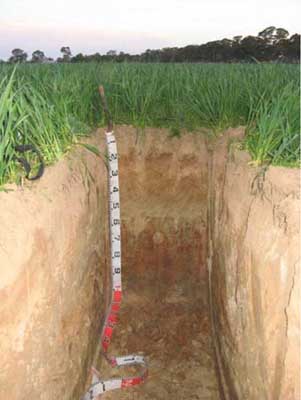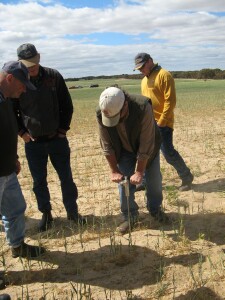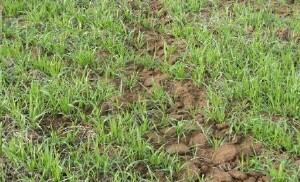What is a soil health management plan
Key questions for a soil health management plan | Why have a soil health management plan?
Back to Soil health management plan
A SHMP can be as simple or as complex as the knowledge, skill and time of the farm manager allow. The main elements of the SHMP are soil inventory, monitoring, planning and management.
The elements
The basic elements of a soil health management plan answer three questions:
1. What do we have? = Soil inventory and interpretation.
2. How are things going? = Assessment and monitoring.
3. What needs to be done? = Planning and management.
1. Soil inventory and interpretation
This is the primary representation of soils on the farm and should include:
- Identification of major soil differences across the farm.
- Soil profile descriptions for full depth of major soils.
- A record of the critical differences between them.
- Ranking — best to worst (could depend on purpose).
- Any special considerations for management.
Identifying the major soils
Surface soil colour and textural differences are fairly obvious features, particularly when the soil is bare or is cultivated. Farmers will often use terms such as 'grey loam' or 'black clay' to describe their soil. Presence of cracking soils, stony areas, land subject to inundation, and general landform also provide indicators of soil differences. History of the farm, the order in which land was cleared, and the original vegetation cover can provide clues to the underlying soil and land quality. Recent technological innovations, particularly yield mapping, the use of ground based sensors (EM38) and interpretation of satellite imagery are proving invaluable for identifying soil-based production issues and for zoning paddocks for precision agriculture. The SHMP provides a framework for properly documenting these soil differences and issues.
| Soil profile descriptions Soil investigations must go deeper than the surface 10 cm. Total soil depth available for water storage and root growth can be extremely variable. Subsoil properties may restrict growth in ways that can be overcome by management or may be permanent features of the soil that have to be recognised and adapted to. If irrigation water is to be applied on the farm then knowledge of soil properties for the full profile (depth ~1-1.5 m) is essential. A soil auger or post hole digger may give sufficient information, particularly for confirming soil properties, but, ideally, a soil pit excavated by backhoe will give the best indication of soil horizons and structure (Figure 1). The main horizons should be sampled and sent away for chemical and physical analysis if funds permit. A well described soil profile supplemented by chemical and physical data provides a good reference site for the farm and for other landholders in the district. Critical soil differences Soil health (or soil quality) is described in terms of the capacity of the soil to perform critical functions such as: retain and store water for plant growth, resist erosion, and support traffic (refer to document ‘Soil Health for Victoria’s Agriculture’). Critical soil differences are the soil properties that affect these functions. Some of these properties are inherent to the soil and determine the soil quality, soil type or class of soil. These properties may change but only very slowly over decades, centuries or millennia (e.g. soil texture). It is these enduring inherent soil properties that should be described and mapped as part of the soil inventory. Other soil properties are changeable over the short term, during a season or over several management cycles. Such properties are dynamic, respond to management and also affect the soil's capacity to perform key functions (e.g. pH and soil structure affect availability of nutrients, soil air and water). The soil condition with regard to dynamic properties indicates soil 'health' and is therefore important for the assessment and monitoring elements in the SHMP. |  |
Some important critical soil properties for the inventory are: surface soil colour and texture, subsoil texture, total soil depth (or rooting depth), stoniness (rocks, gravels, buckshot), topsoil or A horizon thickness, surface drainage status, etc. The assistance of a soil specialist and training of farmers in some simple field methods to assess soil is necessary support for the development of a farm soil inventory.
Ranking the soil types
During the process of creating a soil inventory, comments should be recorded concerning the history and performance of different paddocks. A simple ranking of the soils from best performers to worst can do two things: it can indicate inherent differences in soil and land quality, and it may also highlight some management issues that have arisen in the past.
Special considerations for management
Special considerations for management will arise during the initial soil inventory and ranking. Issues for consideration include: erosion hazard, waterlogging and inundation, dispersive (sodic) soil, soil acidity, and structurally degraded soil.
Using available soil information
A large amount of soil information exists here on VRO. Scanned soil survey reports and maps are available for download and are useful to gain a general idea of local soil types. However, most of the soil and land surveys have been conducted at regional scales that have insufficient spatial detail to be used to map soil at a farm scale. In addition to the soil survey reports there are several hundred examples of regional soil types complete with images, profile descriptions and analytical data. The VRO pages also include information on soil degradation processes and soil management. The web pages provide support for anyone developing a SHMP but direct consultation of a soil scientist will be needed for local interpretation and planning.
2. Assessment and monitoring
The farmer needs to know how farming practices are affecting the soil. The soil inventory answers the question 'what's out there?' Assessment and monitoring should answer the question 'How well are things going?' A balanced program will include all of the following:
- Soil and plant sampling and laboratory analyses.
- Paddock walks and soil condition assessment.
- Evaluation of crop and animal production, quality and health.
What factors should be monitored and how often should monitoring occur?
There is no 'one size fits all' design for assessment and monitoring that can cover all soil and all farming systems. An appropriate assessment and monitoring routine depends on: land use, the practices and changes in practice, critical issues such as erosion, and the expected rate of change (e.g. soil carbon is slow to change whereas soil nitrogen changes rapidly).
Guidelines for soil and plant sampling for analysis are provided by DPI and commercial laboratories. Consideration should be given to timing, soil depth, tillage and fertiliser practices (e.g. banding, zero tillage). To monitor soil change, consistent methods must be applied in the field and laboratory from year to year. Surplus from large soil samples taken (more than is sent to the lab) can be held at the farm as reference samples in case methods or laboratories are changed. Samples for archiving should be thoroughly air dried and stored in water tight and vermin proof containers.
Paddock walks are opportunities for systematic visual and tactile assessment of soil to develop a familiarity with differences between paddocks, soils and seasons.
These walks can be incorporated into crop monitoring and animal husbandry activities. Useful observations can be made of soil surface condition such as crusts, evidence of erosion, ponding of water, surface compaction etc. and supported by taking reference photographs.
| A simple penetrometer indicates soil strength and moisture content A simple penetrometer can easily be carried during a paddock walk to serve as a useful indicator of soil moisture conditions and subsoil physical strength. Farmers are increasingly adopting technology to assist in crop management. Yield monitors, satellite data, soil moisture sensors, and electromagnetic induction surveys are all examples of readily available technology. As with any new approach, expert help may be required for proper set up of equipment, training in applications, and interpretation of data. Site or farm specific calibrations should also be considered because soils are so diverse and variable. Further information for soil health monitoring A soil health check ideally includes an assessment of soil physical condition, chemical fertility and biological functions. The Healthy Soils project's review of soil health tools provides a summary of useful methods. |  |
3. Planning and management
Knowledge of soils, soil differences and soil condition needs to be translated into action - what management actions are required to maintain or improve soil condition and get the best from the soil?
Crops and livestock
Profitable production of food and fibre is the primary business goal. The aim of a SHMP is to align soil management with this goal. Decisions about crop type, rotations, and stock management all have an impact on, and are affected by, soil health. Crops are not all equal in terms of their fertility requirements, rooting depth or potential to protect soil. Hard hoofed animals can readily cause damage to soil that will impact subsequent plant growth.
Hard hoofed animals can readily cause damage to soil. Compaction by sheep treading on moist unprotected ground.
Grazing and cropping combinations must be carefully managed. Timing and sequencing of crop and stock operations, paddock by paddock, must not be left to chance but should be planned to achieve triple benefits for crop, stock and soil.
Impact on following crop along a stock track created during the pasture phase.
 Stock track |  Hooves |
Amendments such as fertilisers, lime, gypsum, composts, and feed supplements are major business expenses. It is essential to know where and when these amendments are needed, the amounts that should be applied, and their potential economic benefits. Conversely, the cost and penalties should also be known for not using appropriate amendments at the right time, in the right place and at the best rates. The business strategy for amendments must be based on good knowledge of the soil inventory, crop history, and soil testing.
Tillage and traffic management
There are many different operations that can be included under the general term, 'tillage'. Any action associated with mechanical disturbance of soil in the preparation of ground for growing crops, burial of weeds, or incorporation of organic matter is tillage. Worldwide, the evidence is mounting that soil health benefits are greater where disturbance is kept to a minimum.
Decisions regarding tillage are critical for the business and for soil health. Fuel, machinery depreciation and implement wear are significant costs. A SHMP should account for differences in soil conditions and how tillage affects soil structure. It is much easier to degrade soil structure with tillage than it is to build good structure. Evaluation of existing equipment, condition, purpose and performance is an essential component of the SHMP.
Control of traffic across soil is also an important management tool for soil health. Soil becomes strong enough to support the loads imposed on it. Dry soil is strong - moist soil is weak. Dense soil is strong - loose soil is weak. Loose moist soil is good for plants, dense dry soil is good for supporting wheeled vehicles. A healthy soil for supporting traffic is not a healthy soil for growing crops, and vice-versa.
The simplest form of controlled traffic is to only put traffic on paddocks when soil structural damage is likely to be low. Fully developed controlled traffic confines traffic to consistent routes or tramlines, is managed by GPS guidance systems, and has machinery axle widths optimised to minimise the trafficked area. Changing from uncontrolled to controlled traffic farming is therefore costly and needs to be planned in the business time frames for machinery replacement.
Adoption of minimum tillage and even zero tillage systems is increasing in Victoria. Controlled traffic farming has not yet been widely adopted but the efficiencies in fuel usage, management of inputs, and demonstrated yield benefits should serve to encourage rapid change in traffic management.


